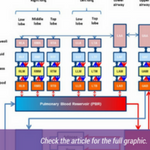Author: Piet van der Graaf, PhD, PharmD on March 30, 2018 
A Unique Collection of State-of-the-Art Pharmacometric and Systems Pharmacology Approaches in Pulmonary Pharmacology, Toxicology, and Therapeutics
The lung is an unusual organ from the perspective of drug delivery, since it is amenable to local administration. This concept has been successfully translated to clinical practice in pulmonary disease areas like asthma and chronic obstructive pulmonary disease (COPD). Physiologically-based pharmacokinetic (PBPK) models are increasingly being employed to design modalities and dosing regiments that optimize the exposure at the pulmonary site of action whilst reducing systemic exposure, thus maximizing the therapeutic benefit to patients. In other cases, similar models are used to predict and optimize exposure at the site of action in the lung after systemic administration, for example, in the case of antibiotics.
As illustrated by this Virtual Issue dedicated to the lung, pharmacometric and systems pharmacology approaches have been developed for a range of pulmonary diseases in areas such as allergy and inflammation (asthma, COPD), oncology, infectious diseases (including tuberculosis), cystic and pulmonary fibrosis, and circulation (pulmonary hypertension).
PSP's Lung Virtual Issue is a resource of state-of-the-art original research, reviews, and tutorials of pharmacometrics and systems pharmacology science and applications in the field of pulmonary pharmacology, toxicology, and therapeutics.
Image by Lu, et al., CPT Pharmacometrics Syst. Pharmacol., doi: 10.1002/psp4.12034, is licensed under CC BY-NC-ND 4.0. ©2015 The authors.

The comment feature is locked by administrator.